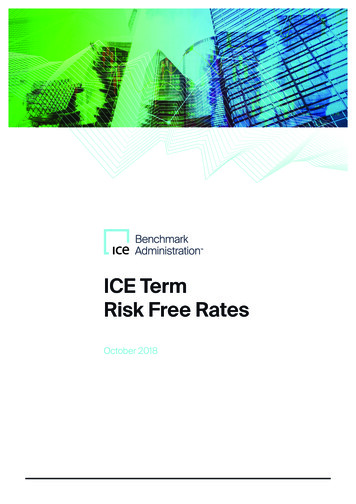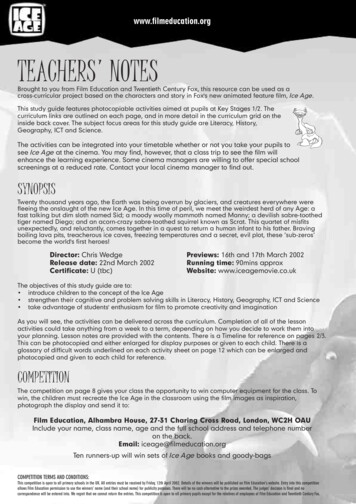
Transcription
ICE TermRisk Free RatesOctober 2018
Contents3Executive Summary4A Brief Introduction to Risk Free Rates6The Development of Term Risk Free Rates8Possible Methodologies for Constructing Term Risk Free Rates10IBA Proposals for Term SONIA: ICE Term RFR - Forward-Looking - GBP15ICE Term RFR - Forward-Looking - GBP: Historical Testing17The ICE Term Risk Free Rates (RFR) Portal20Disclaimers22Appendix 1: Overview of IBA23Appendix 2: ICE Term Risk Free Rates - Methodologies Copyright 2018 ICE Benchmark Administration LimitedICE Term Risk Free Rates2
Executive summaryThe introduction of alternative risk free rates is one of the most important developments in the financial markets in recent years. Thesealternative interest rates offer significant promise as benchmarks, as they provide a robust indication of short-term borrowing costs insome of the largest economic zones across the globe.The alternative risk free rates measure overnight borrowing costs in either unsecured or secured financial markets. In this regard theyare very different from the “IBORs” (e.g. LIBOR, EURIBOR, TIBOR), the most actively used interest rate benchmarks in financial contractstoday. This is because the IBORs are typically published for multiple forward-looking tenors (or terms) which seek to measure expectedwholesale, unsecured bank borrowing costs over specified periods (e.g. one, three, six and twelve months).Although the use of alternative risk free rates in most derivative contracts is expected to be uncomplicated, their use in respect of certainother non-derivative or “cash” products may be more challenging.Many market participants value having forward-looking term rates in their financial contracts for budgeting, cash flow and riskmanagement purposes. Large and small businesses generally value certainty in calculating their interest expense and other contractualpayments. This, and the ability to know forward-looking interest rates in advance for one, three, six and twelve month time periods, havemade the IBORs attractive benchmarks in certain areas. Retail borrowers also value knowing what their obligations will cost in advance,particularly those with mortgages or long-dated student loans.In addition, many financial planning and operating systems are designed for contracts that reference forward-looking term rates and maynot be equipped to compound interest accruals on a daily basis. Re-designing these systems could prove to be an expensive and timeconsuming procedure for many businesses.Given the benefits associated with forward-looking term rates, many market participants and working groups have expressed significantinterest in the development of term structures for alternative risk free rates in certain use cases, noting that these would be helpful infacilitating their adoption.ICE Benchmark Administration Limited (IBA) is committed to helping the financial markets develop such term structures. As a marketleading provider of regulated benchmarks, administering ICE LIBOR, ICE Swap Rate and the LBMA Gold and Silver Prices, IBA is uniquelypositioned to help build and publish robust and sustainable term structures for the risk free rates.In this regard, IBA has taken two steps.First, IBA has developed a preliminary methodology, based on futures contracts data, to derive a forward-looking term rate for SONIA (theSterling Overnight Index Average, which was selected as the alternative risk free rate for the Sterling markets). The methodology is set outin detail in this paper. IBA has also outlined some other approaches that could be used to derive forward-looking term rates for SONIA, ifmarket conditions and end-user demand warrant this in the future.These solutions could also be leveraged for the other alternative risk free rates as the mathematics and processes proposed to deriveforward-looking term rates for SONIA could be applied to other risk free rates as markets and user appetite develop.Secondly, IBA has launched the ICE Term Risk Free Rates (RFR) Portal. IBA expects this webpage to be a valuable resource for marketparticipants, providing three key pieces of information on alternative risk free rates on a daily basis:1. Forward-looking one, three and six month term risk free rates, initially for SONIA, derived from futures contracts and published SONIAdata1;2. Realised simple and compounded averages for one, three and six month periods, derived from historical, published risk free rate data2;and3. The published overnight risk free rate3.IBA is inviting feedback from market participants on the proposed methodologies to derive forward-looking term rates set out in thispaper and on the ICE Term RFR Portal. It is important to hear from stakeholders on how IBA can enhance its approach in order to supportthe development and adoption of term risk free rates and make the ICE Term RFR Portal as useful and informative as possible.123IBA intends to publish other forward-looking term risk free rates, including term rates for SONIA derived from overnight index swaps data, when market conditions, trading infrastructure andgovernance permit thisAs per footnote 1Initially for SONIA, SOFR (the risk free rate for the US dollar markets) and TONA (the risk free rate for the Japanese yen markets). IBA is in discussions with SIX Exchange Ltd. regarding thepotential re-distribution of SARON (the risk free rate for the Swiss franc markets). If permitted to do so, IBA also intends to re-distribute ESTER (the euro area risk free rate) when this is published Copyright 2018 ICE Benchmark Administration LimitedICE Term Risk Free Rates3
A Brief Introduction to Risk Free RatesBenchmark Reform and the Call to Develop Risk Free RatesIn February 2013, the G20 asked the Financial Stability Board (FSB) to undertake a fundamental review of major interest rate benchmarksand of plans for reform in order to ensure that these plans were consistent and coordinated and that benchmarks were robust and usedappropriately. The FSB published a report in July 20144 recommending the development and use of alternative nearly risk free referencerates (RFRs), particularly in markets where transactions are well-suited to such rates (e.g. derivatives).The Selection of Risk Free RatesAlongside a series of reform programmes for existing interest rate benchmarks, various working groups were established to identify andselect RFRs for sterling, US dollar, Japanese yen, Swiss franc and the euro area currency markets.SterlingThe Bank of England established the Working Group on Sterling Risk-Free Reference Rates (SWG), which recommended the reformedSterling Overnight Index Average (SONIA) as its preferred Sterling RFR5. The Bank of England assumed the administration of SONIA fromthe Wholesale Market Brokers Association (WMBA) in April 20166 and, following a period of consultation, began publishing SONIA with areformed methodology from April 20187.SONIA8 is a measure of the rate at which interest is paid on Sterling overnight wholesale funds in circumstances where credit, liquidity andother risks are minimal. It is calculated as a trimmed mean of eligible unsecured overnight deposit transactions that are greater than orequal to 25m in value, reported as part of the Bank of England’s Sterling Money Market (SMM) data collections.US dollarThe Board of Governors of the Federal Reserve System and the Federal Reserve Bank of New York convened the Alternative ReferenceRates Committee (ARRC), which identified the Secured Overnight Financing Rate (SOFR) as its recommended US dollar RFR9. In April2018, in cooperation with the US Office of Financial Research, the Federal Reserve Bank of New York started to publish SOFR10.SOFR11 is a broad measure of the cost of borrowing cash overnight collateralised by US Treasury securities. It is calculated as a volumeweighted median of transaction-level tri-party repo data collected from the Bank of New York Mellon, as well as GCF Repo12 transactiondata and data on bilateral Treasury repo transactions cleared through Fixed Income Clearing Corporation’s (FICC) Delivery-versusPayment (DVP) service.Japanese yenIn Japan the Study Group on Risk-Free Reference Rates (the Study Group) was established and identified the uncollateralised overnightcall rate published by the Bank of Japan, also known as the Tokyo Overnight Average rate (TONA), as the Japanese Yen RFR13.TONA14 is based on data supplied by information providers in respect of overnight transactions brokered in the uncollateralised call moneymarkets (where financial institutions lend and borrow short-term funds). The rate is calculated as the volume-weighted average of thesetransactions.Swiss francThe National Working Group on Swiss Franc Reference Rates (NWG) was established to reform the Tom-next Overnight Index Swap (TOIS)fixing. The NWG subsequently focussed its reform efforts on Swiss Average Rate Overnight (SARON), published by SIX Swiss ExchangeLtd, which it went on to recommend as the Swiss Franc RFR15.SARON16 represents the overnight interest rate of the secured funding market for Swiss Francs. It is calculated as a volume-weightedaverage based on executed repo transaction data and qualifying trade quotes from the SIX Repo Ltd. trading platform.45678910111213141516Reforming Major Interest Rate Benchmarks, 22 July, 2014Bank of England Press Release, 28 April, 2017Bank of England Press Release, 13 April, 2016Bank of England Press Release, 23 April, 2018SONIA BenchmarkARRC Press Release, 22 June, 2017Federal Reserve Bank of New York Statement, 3 April, 2018Secured Overnight Financing Rate DataThe General Collateral Finance Repo Service offered by FICCStudy Group Report on the Identification of a Japanese Yen Risk-Free Rate, December 2017Call Money Market DataNWG MilestonesSwiss Reference Rates Copyright 2018 ICE Benchmark Administration LimitedICE Term Risk Free Rates4
EuroThe Working Group on Euro Risk-Free Rates (EWG) was established by the European Central Bank (ECB), the Belgian Financial Servicesand Markets Authority (FSMA), the European Securities and Markets Authority (ESMA) and the European Commission and recommendedthe Euro short-term rate (ESTER) as the euro area RFR17. The ECB will begin publishing ESTER by October 201918.ESTER19 will reflect the wholesale euro unsecured overnight borrowing costs of euro area banks. It will be calculated as a volumeweighted trimmed mean of overnight unsecured fixed rate euro deposit transactions over 1m in value that are reported by banks inaccordance with the ECB’s money market statistical reporting (MMSR) requirements.Figure 1: The Selected Risk Free istratorBank of EnglandFederal ReserveBank of New YorkBank of JapanSIX SwissExchange LtdEuropeanCentral BankSecured curedRateUnsecuredRateECB Press Release, 13 September, 2018ECB Press Release, 28 June, 2018. Until ESTER is available, the ECB will publish figures referred to as pre-ESTER, which market participants can use to assess the suitability of the new rateEuro short-term rate (ESTER) Copyright 2018 ICE Benchmark Administration LimitedICE Term Risk Free Rates5
The Development of Term Risk Free RatesTerm Rates and Overnight RatesThe most actively used interest rate benchmarks are the IBORs, such as LIBOR20, EURIBOR21 and TIBOR22. The IBOR benchmarks aretypically published for multiple forward-looking tenors (or terms). Having a forward-looking term structure means the IBOR settingsprovide a measure of the expected average rate over a specified period (a “term rate”). These forward-looking term rates can be used tocalculate upcoming contractual payments (such as interest due) at the beginning of an accrual period based on a forward-looking rate setin advance as opposed to having to wait until the end of the accrual period to calculate a payment based on overnight rates.For example, a retailer that needs to borrow money in late September to fund increased inventory prior to the holiday season can know itsfloating rate cost of debt through to year-end in advance by using a three month IBOR rate rather than having to calculate this cost at theend of the period based on historical overnight rates. This feature has made the IBORs attractive to borrowers (and other financial marketsparticipants using floating interest rates) that value a forward-looking rate, certainty and advance knowledge in respect of their contractualpayments for budgeting, risk management or operational purposes.In contrast to the IBORs, the selected RFRs are all “overnight rates”. This means that they provide a measure of interest rates paidovernight in circumstances where other risk factors are negligible. It was recognised during the RFR selection processes that theovernight rates being considered would not replicate the forward-looking term structures of the IBOR benchmarks without modification.However, the potential for developing forward-looking term rates for RFRs (“term RFRs”) was generally acknowledged by the workinggroups as a feature that would be desirable and aid adoption of the RFRs in markets (e.g. for non-derivative or “cash” products, such asloans and notes) where participants value forward-looking rates, certainty and advance knowledge.Figure 2: IBOR TenorsTENORON/SN1W2W1M2M3M6M9M12MLIBOR ( , , , CHF, )PPOPPPPOPEURIBOR23 ( )OP[P]P[P]PP[P]PTIBOR24 ( , euroyen)OPOPPPPOPLIBORThe Case for Developing Term RFRsThe FSB25 has stated that the transition of most derivatives to RFRs is important in ensuring financial stability. However, it hasacknowledged that RFRs may not be optimal for use in certain circumstances and that term rates may be suitable where it is notpracticable to use a realised compounded RFR observed over, or a measure of observed RFRs set at the beginning of, an accrual periodin order to determine an interest rate payment. Accordingly, the FSB has expressed support for exploring the creation of term RFRs incertain use cases in jurisdictions that have expressed a desire or need for them.RFR working groups have also noted that the development of forward-looking term rates might assist with a transition to RFRs across thevarious markets.The SWG26 stated that it expects strong demand for term SONIA in corporate lending and securitisations. It also expects moderatedemand in other areas such as retail loans, notes, securities lending and uncleared derivatives. Weak demand for term SONIA isexpected in exchange traded and cleared derivatives markets. However, the SWG noted that market participants will require hedges forfinancial instruments (such as loans and bonds) which reference RFRs and so some use of term SONIA in the derivatives markets is likelyto occur.The SWG noted that many market participants would like to see forward-looking term rates due to operational and technological systemswhich require payment amounts to be determined at the start of an accrual period as well as the economic desire to avoid interest rateexposure over short, pre-determined periods. Market participants also highlighted that the use of term rates helps support liquiditymanagement and cash flow planning.LIBOREURIBORTIBOR23In June 2018, EMMI announced the cessation of the 2 week, 2 month and 9 month EURIBOR tenors as of 3 December, 2018 EMMI Press Release, 6 June, 201824On 2 October, 2018, JBA TIBOR Administration published the 1st Consultative Document on the Approach for Integrating Japanese yen TIBOR and euroyen TIBOR25Interest rate benchmark reform – overnight risk-free rates and term rates, 12 July, 201826SWG Consultation on term SONIA Reference Rates, July 2018202122 Copyright 2018 ICE Benchmark Administration LimitedICE Term Risk Free Rates6
In the US dollar markets, the ARRC considers that SOFR should be relatively easy to incorporate into derivative contracts due toparticipants’ familiarity with contracts referencing overnight rates27. However, the ARRC has acknowledged that market participants usingcertain cash products may find overnight rates or even realised averages of overnight rates unfamiliar and may find this type of transitionmore difficult. This is because such rates are either not forward-looking or not predetermined at the start of an accrual period, featuresthat certain users may be accustomed to or which their systems may require. Consequently, to seek to accommodate these participantsand facilitate a transition to SOFR for such cash products, the ARRC would like to see the creation of term SOFR. This is highlighted inthe ARRC’s “Paced Transition Plan”28, which is intended to create conditions in which a robust term rate based on derivatives referencingSOFR may be developed for use in some cash products by the end of 2021.In Japan, the Cross-Industry Committee on Japanese Yen Interest Rate Benchmarks (the Cross-Industry Committee) was establishedin August 201829. The Cross-Industry Committee formed three sub-groups, including the “Sub-Group for the Development of TermReference Rates”, as it considered that the development of term rates would become necessary upon the transition of existing IBORs toRFRs29.A EWG working group level survey noted that the development of a term rate for the euro area RFR would be important for both legacyand new contracts. Interest rate derivatives, retail products and syndicated loans were considered the areas most reliant on such rates31.Status of the Development of Term RFRsFollowing the selection of the RFRs, the focus of the working groups has now shifted to facilitating adoption of the new rates. As thedevelopment of term rates could aid adoption in certain cases, the market appetite for term RFRs, and potential methodologies toproduce these, are now being actively discussed and investigated.In the UK, the SWG was reconstituted in January 2018 with a mandate to catalyse a broad-based transition to using SONIA as theprimary Sterling interest rate benchmark in bond, loan and derivatives markets by the end of 202132. This mandate includes developingand promoting a term rate where appropriate. Due to the important role that term rates may have in facilitating a transition to SONIA,particularly in the loan and bond markets, the SWG has published a consultation paper33 requesting feedback on potential forward-lookingterm SONIA constructions, their use cases, and their role in facilitating transition. The consultation paper proposes various methodologiesto derive term SONIA based on prices or quotes observed in SONIA index futures or overnight index swaps markets or a combination ofthese.In the US, the ARRC was reconstituted in March 2018 to ensure the implementation of its “Paced Transition Plan”34. This plan includesthe development of active and robust markets in futures and/or overnight index swaps referencing SOFR, from which a term rate couldbe constructed. The ARRC has already discussed several potential methods for deriving term SOFR, including from SOFR futures orovernight index swap transaction data or actionable market quotes35.In Japan, the Sub-Group for the Development of Term Reference Rates36 has been established to deliberate on the development of termreference rates based on TONA.In Switzerland, the NWG has surveyed users of Swiss Franc LIBOR to assess the need for term SARON37. This survey included aconsideration of a backward-looking term rate based on the repo market and forward-looking term rates based on SARON futures,overnight index swaps and repos. The NWG has released a term sheet for a SARON futures contract and invited exchanges to startoffering the product38. Sub-working groups of the NWG are currently assessing the market’s preferences regarding, and the feasibility ofdeveloping, the different term SARON approaches.In the euro area, a sub-group of the EWG focussing on term RFRs has been established39 to determine and recommend a term ratemethodology for ESTER. The sub-group has already discussed various potential methodologies based on futures, OIS quotes andtransactions, alongside other backward-looking methodologies.ARRC Second Report, March 2018ARRC Minutes, 31 October, 2017Bank of Japan Announcement, 20 July, 201830Cross-Industry Committee Minutes, 1 August, 201831EWG Minutes, 11 July, 201832Bank of England Press Release, 29 November, 201733SWG Consultation on Term SONIA Reference Rates, July 201834ARRC Press Release, 7 March, 201835ARRC Second Report, March 201836Sub-Group for the Development of Term Reference Rates - Terms of reference37Outreach to Swiss corporates on CHF Libor, 22 June, 2018383M SARON Futures Contract Specifications (NWG recommendation), 22 June, 201839Working group on euro risk-free rates - Terms of reference for subgroup 2 on the identification and recommendation of a term structure on RFRs, 20 April, 2018272829 Copyright 2018 ICE Benchmark Administration LimitedICE Term Risk Free Rates7
Possible Methodologies for Constructing Term Risk Free RatesTerm RFRsA term RFR should seek to indicate the market’s expectation of the average overnight rate over a specified period (e.g. one, three orsix months). It can then be used to satisfy financial and operational requirements to calculate upcoming contractual payments at thebeginning of an accrual period using forward-looking rates. This would give end users of the rate (e.g. corporations, small business, retailborrowers, etc.) greater certainty and would support liquidity management and cash flow planning.Forward-looking term rates can be derived from market data points that offer an indication of the market’s expectation of future RFRsettings. At the current time, the deepest sources of data from which to derive expected RFR settings come from forward-lookingderivative contracts such as futures contracts and interest rate swaps that reference RFRs.Derivatives Markets Referencing RFRsThere are two primary derivatives markets that may be appropriate for deriving term RFRs: the overnight index swaps (OIS) market and thefutures market.Overnight Index SwapsOIS are interest rate swap contracts under which periodic payments calculated by applying a fixed interest rate to a given notionalamount for a specified period are swapped against payments calculated by applying an overnight floating rate, such as a RFR averaged orcompounded40 over that specified period, to that same notional amount.For example, a typical OIS contract in the Sterling markets would reference a set notional amount (e.g. 100m) with one party receivinga fixed rate multiplied by the set notional amount for a predetermined time period (e.g. one month) while paying the other party thecompounded SONIA rate over the same period multiplied by the same set notional amount.Market participants can use OIS to hedge short-term interest rate movements, to speculate on future interest rate policy or for arbitragepurposes. Generally OIS are entered into for short maturities and are traded “over-the-counter” or OTC (i.e. not executed on an exchange).OIS markets referencing some RFRs are well developed (e.g. SONIA), whereas others are developing or still to be established.Figure 3: Example of a SONIA Overnight Index SwapFixed RatePayerFixed interest rate x NotionalAveraged or compounded SONIA over the accrual period x NotionalFloating RatePayerFuturesInterest rate futures are exchange-traded, cleared derivative contracts. The price of a futures contract will vary as expectations regardingthe future value of the underlying reference floating interest rate (e.g. a simple average RFR) change. Futures contracts are traded innotional units and have a fixed maturity date. Participants can buy or sell the contracts on any business day.For example, a participant could enter a one month SONIA index futures contract at the prevailing market price on a given day, whichwould have a delivery price at maturity equal to 100 minus the simple monthly average SONIA rate.Interest rate futures on overnight rates, such as RFRs, may be used to hedge against short-term interest rate movements, for speculationor arbitrage. Futures markets referencing RFRs are either developing (e.g. SONIA, SOFR), or are illiquid or still to be established (e.g.SARON, TONA, ESTER).40Either methodology can be used Copyright 2018 ICE Benchmark Administration LimitedICE Term Risk Free Rates8
Figure 4: Example of a Futures ContractExchangeFutures entered into on anexchange and centrally clearedAnonymised CentralLimit Order BookBuyerSellerClearing HouseCentral CounterpartyIntermediationPrice Sources and Methodology Considerations for Term RFRsThere are various potential mechanisms that may be used to source prices for derivatives referencing RFRs, which can then be used tocalculate expected average rates for particular tenors.Transaction DataExecuted transaction data may be used for OIS and futures contracts referencing RFRs sourced from central counterparties, traderepositories or the trading venues themselves. These prices would need to be used alongside a financial model to generate yield curvesfor the required tenors (e.g. one, three and six months) as the transaction maturities are unlikely to align perfectly with the term ratesrequired by market participants.The feasibility of this approach depends on the development of liquid and robust underlying derivatives markets to provide sufficient pricedata to generate the relevant yield curves. It also requires prices to be made available on a timely basis to an administrator in order tocompute the rates in an efficient manner. Furthermore, any model would need to be transparent and verifiable by users and the regulatorycommunity.Firm QuotesFirm, tradable quotes from market makers may also be obtained for OIS and futures contracts referencing RFRs, sourced from tradingvenues. The feasibility of this approach again depends on the development of liquid, robust and transparent underlying derivativesmarkets. The use of firm quotes would broaden the data set substantially when compared with an approach using only transaction data.However, consideration would need to be given to maintaining the representativeness of the rate and the robustness of the underlyingdata. This approach would require the quotes to be made available on a timely basis to an administrator and any model would need to betransparent and verifiable (as noted above).In addition to electronic trading venues, firm quotes could also be obtained from a point-in-time auction process for OIS trades in order togenerate a term rate. Such an auction process would need sufficient interest to generate a representative price.HybridA hybrid of the above approaches, using executed transaction data alongside firm quotes, or settlement prices, could also be used todetermine term RFRs. This approach could theoretically widen the data set relative to a methodology based solely on transaction datawhilst retaining high levels of price transparency and representativeness of the rate. The above-mentioned considerations would applyregarding term RFRs constructed from transaction data and quotes, or settlement prices.In all cases, the management and scope for oversight of both the data input process and the process of determining term RFRs mustbe considered when selecting the best approach. The potential for conflicts of interest and opportunities for manipulation to arise shouldbe assessed and mitigated. This may be achieved by a regulated benchmark administrator through robust data submission practices,surveillance and appropriate oversight and governance (including the use of an oversight committee). Copyright 2018 ICE Benchmark Administration LimitedICE Term Risk Free Rates9
IBA Proposals for Term SONIA: ICE Term RFR - Forward-Looking - GBPTerm SONIAIn line with the considerations above, any forward-looking term rate for SONIA should seek to indicate the market’s expectation ofthe average SONIA rate over a pre-determined time period. Market participants can then use these term rates to calculate upcomingcontractual payments linked to such rates (e.g. interest payments) in advance of the relevant accrual period.To derive term SONIA, IBA, a benchmark administrator authorised and regulated under the EU Benchmarks Regulation41, has consideredboth the OIS and futures derivatives markets referencing SONIA. IBA believes that any methodology used to produce forward-lookingterm rates for SONIA (as the RFR for the Sterling markets), or a derivation thereof, could potentially be applied to produce term rates for theother RFRs (i.e. for US dollar, Japanese yen, Swiss franc and euro currencies).Please see Appendix 1 for further information about IBA and its activities as a benchmark administrator.SONIA Derivatives Markets Available to Create Term Rates for SONIASONIA Overnight Index SwapsThe SONIA OTC OIS market is well established but episodic in nature. Trading in SONIA OIS contracts tends to be focussed aroundMonetary Policy Committee (MPC) meetings and other dates where public statements or information releases may impact interest rateexpectations. Trading in SONIA OIS is spread across a range of tenors with the majority of contracts maturing within six months. It is alsoworth noting that SONIA OIS are generally forward-starting in order to coincide with MPC meeting and quarterly International MonetaryMarket (IMM) dates (i.e. accruals will start on a future date, not at the time the OIS contract is entered into)42.It is IBA’s view that the SONIA OIS market could be used to derive forward-looking term rates in the future but that it currently lacks thenecessary price transparency to do this based on either transactions or firm quotes. There are also modelling challenges in trying toderive a SONIA yield curve from OIS data today due to the current prevalence of forward-starting (as opposed to spot) OIS in the market.However, assuming developments in the SONIA OIS market lead to enhanced liquidity in spot-starting contracts and allow for transparenttrading on regulated pla
SARON16 represents the overnight interest rate of the secured funding market for Swiss Francs. It is calculated as a volume-weighted average based on executed repo transaction data and qualifying trade quotes from the SIX Repo Ltd. trading platform. 4 Reforming Major Interest Rate Benchmarks, 22 July, 2014 5 Bank of England Press Release, 28 .











